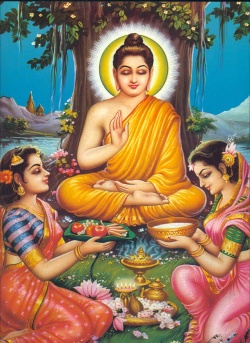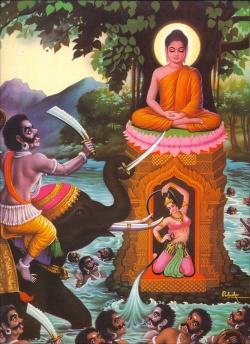The third noble truth
What is the Noble Truth of the Cessation of Suffering? It is the remainderless fading and cessation of that same craving; the rejecting, relinquishing, leaving and renouncing of it. But whereon is this craving abandoned and made to cease? Wherever there is what seems lovable and gratifying, thereon it is abandoned and made to cease.
There is this Noble Truth of the Cessation of Suffering: such was the vision, insight, wisdom, knowing and light that arose in me about things not heard before.
This Noble Truth must be penetrated to by realising the Cessation of Suffering....
This Noble Truth has been penetrated to by realising the Cessation of Suffering: such was the vision, insight, wisdom, knowing and light that arose in me about things not heard before.
[Samyutta Nikaya LVI, 11]
The Third Noble Truth with its three aspects is: ‘There is the cessation of suffering, of dukkha. The cessation of dukkha should be realised. The cessation of dukkha has been realised.’
The whole aim of the Buddhist teaching is to develop the reflective mind in order to let go of delusions. The Four Noble Truths is a teaching about letting go by investigating or looking into - contemplating: ‘Why is it like this? Why is it this way?’ It is good to ponder over things like why monks shave their heads or why Buddha-rupas look the way they do. We contemplate...the mind is not forming an opinion about whether these are good, bad, useful or useless. The mind is actually opening and considering. ‘What does this mean? What do the monks represent? Why do they carry alms bowls? Why can’t they have money? Why can’t they grow their own food? We contemplate how this way of living has sustained the tradition and allowed it to be handed down from its original founder, Gotama the Buddha, to the present time.
We reflect as we see suffering; as we see the nature of desire; as we recognise that attachment to desire is suffering. These insights can only come through reflection; they cannot come through belief. You cannot make yourself believe or realise an insight as a wilful act; through really contemplating and pondering these truths, the insights come to you. They come only through the mind being open and receptive to the teaching - blind belief is certainly not advised or expected of anyone. Instead, the mind should be willing to be receptive, pondering and considering.
This mental state is very important - it is the way out of suffering. It is not the mind which has fixed views and prejudices and thinks it knows it all or which just takes what other people say as being the truth. It is the mind that is open to these Four Noble Truths and can reflect upon something that we can see within our own mind.
People rarely realise non-suffering because it takes a special kind of willingness in order to ponder and investigate and get beyond the gross and the obvious. It takes a willingness to actually look at your own reactions, to be able to see the attachments and to contemplate: ‘What does attachment feel like?’
For example, do you feel happy or liberated by being attached to desire? Is it uplifting or depressing? These questions are for you to investigate. If you find out that being attached to your desires is liberating, then do that. Attach to all your desires and see what the result is.
In my practice, I have seen that attachment to my desires is suffering. There is no doubt about that. I can see how much suffering in my life has been caused by attachments to material things, ideas, attitudes or fears. I can see all kinds of unnecessary misery that I have caused myself through attachment because I did not know any better. I was brought up in America - the land of freedom. It promises the right to be happy, but what it really offers is the right to be attached to everything. America encourages you to try to be as happy as you can by getting things. However, if you are working with the Four Noble Truths, attachment is to be understood and contemplated; then the insight into non-attachment arises. This is not an intellectual stand or a command from your brain saying that you should not be attached; it is just a natural insight into non-attachment or non-suffering.

